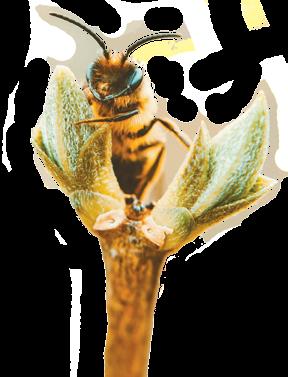
5 minute read
global briefs
Fishy Business
saving Coral Reefs Worldwide
Advertisement
The international Coral Reef initiative (iCRi) has urged governments to take action to save the planet’s remaining coral reefs and their attendant fish populapyvovarova yevheniia/Unsplash.com tions, because collective human impacts are leaving fewer places untouched, with only 15 percent of the Earth’s land mass formally protected and global biodiversity declining at an unprecedented rate. To that end, a new online data platform, mERmAiD (Datamermaid. org)helps scientists and management officials collect, organize and disseminate data on reef fish biomass and diversity, as well as the cover of hard corals, fleshy algae and other benthic groups—all identified by iCRi as key indicators of coral reef health, integrity and function. The newly published 5th global biodiversityOutlookand other sources endorsed by the intergovernmental Panel on biodiversity and Ecosystem services clearly indicate that governments are failing to meet existing global targets for biodiversity and that critical ecosystems like coral reefs will be altered to the point that the biodiversity they harbor, and the services they provide, will be irreparably damaged. Currently, only 2.5 percent of the world’s reefs are being actively protected.
Mucky Duck
Caribbean Offshore Drilling Threatens Florida beaches
The british-owned bahamas Petroleum Company (bPC), under a license from the bahamian government, has begun exploratory oil drilling as deep as 18,000 feet in an area southwest of Andros island and 150 miles from south Florida. Eighteen members of the u.s. Congress, including the entire south Florida delegation, have warned bahamian Prime minister Hubert minnis of the potential for severe, even catastrophic impact if a spill occurs. bPC has made assurances that the exploratory well will be sealed and never used again after it completes its exploratory drilling, and supporters of the project say that the process is closely regulated and accidents are rare. still, Floridians remember the 2010 Deepwater Horizon spill in the gulf of mexico that leaked an estimated 164 million gallons of oil and caused billions of dollars in economic and environmental damage. Even a minor accident that leads to a small oil spill could cost the state millions of dollars and disrupt tourism and businesses. Casuarina mcKinney-lambert, executive director of the bahamas Reef Environment Educational Foundation, says that delicate areas of the Florida Keys would be particularly vulnerable to a spill.

Cold Comfort
Hazardous Pollutants Found in mount Everest snow
manmade perfluoroalkyl and polyfluoroalkyl substances (PFAs) used in water-repellant outdoor gear and daniel prudek/AdobeStock.com linked to birth defects, high cholesterol and increased risk of kidney and testicular cancer have been detected in snow at the top of mount Everest, posing a risk for trekkers, climbers and residents that drink the water. The u.s. Department of Health and Human services Agency for Toxic substances and Disease Registry suggests that exposure to high levels of PFAs may suppress the immune system and increase the risk of getting COviD-19. The PFAs discovery was reported by Kimberley miner, a research assistant professor at the university of maine Climate Change institute, who along with 20 co-authors published a paper, “Deposition of PFAs ‘forever chemicals’ on mt. Everest,” in the online journal scienceofthe TotalEnvironment.The PFAs pollution shows that people unknowingly shed these chemicals. some companies that make outdoor gear are phasing them out, while others cite “technical challenges” in delaying such implementation.

Flying High
Economical Carbon-Neutral Jet Fuel
scientists looking for ways to reduce the amount of carbon dioxide emitted into the atmosphere have increasingly focused on the aviation industry, which accounts for apquintin gellar/Pexels.com proximately 12 percent of transportation-related carbon dioxide emissions. installing heavy batteries aboard aircraft is problematic, but a team of researchers affiliated with several institutions in the uK and saudi Arabia have developed a way to produce jet fuel using carbon dioxide as a main ingredient, as published in the journal NatureCommunications.
The process, which uses an iron catalyst with added potassium and manganese, along with hydrogen, citric acid and carbon dioxide heated to 662° F, forces the carbon atoms apart from the oxygen atoms in CO2 molecules, which then bond with hydrogen atoms to produce the kind of hydrocarbon molecules that comprise liquid jet fuel, with water as a byproduct. This is less expensive than converting hydrogen and water into fuel because it uses less electricity. use of this fuel in aircraft would be carbon-neutral because burning it would release the same amount of carbon dioxide that was used to make it.
NOW offering LASER & HYPERBARIC OXYGEN THERAPY for:

• Wound healing • Pain relief • Inflammation • Fibromyalgia • Arthritis • Diabetes • Neuropathy • Concussion • Migraines
• Athletes • Injuries • Infections CALL NOW TO SCHEDULE YOUR FREE CONSULTATION! ...and more

Hyperbaric Oxygen Therapy tank
Nutrition Works
543 W Franklin St. Womelsdorf, PA 19567
(located 15 mi west of downtown Reading, 30 mi north of downtown Lancaster) 610-589-5182 NutritionWorksClinic.com
Laser Therapy
Supporting Helping Professionals
DYNAMIC & INTERACTIVE ONLINE WORKSHOPS
Expand on current skills while learning experiential therapies and creative methods ~ CEUs & psychodrama hours ~
KAREN CARNABUCCI,
LCSW, TEP
717-466-0788 RealTrueKaren.com
Although honey bees symbolize prosperity, sustainability and environmentalism, and are vital to farmers, they also have a distressing effect on the environment—destabilizing natural ecosystems by competing with native bees. Thousands of beekeeping hobbyists and campaigns to save the bees provide honey bees much more media coverage than native pollinators. High densities of honey bee colonies increase competition with the native pollinators for forage, putting even more pressure on the wild species that are already in decline. Honey bees are extremely general foragers and monopolize floral resources, leading to exploitative competition where one species uses up a resource, not leaving enough to go around. sheila Colla, an assistant professor and conservation biologist at Toronto’s york university, tells scientific American,“beekeeping is for people; it’s not a conservation practice. People mistakenly think keeping honey bees, or helping honey bees, is somehow helping the native bees, which are at risk of extinction. The focus on neonics [pesticide] and honey bees has taken a ton of resources away from conserving wild pollinators from their most important threats.”


Be Pro-Active About Your Health!
Offering: Specializing in:
ä Thermal Imaging ä Cancer, Lyme and Viruses ä IV Therapies ä Cancer Testing & Treatment ä UV Blood Irradiation following the RGCC Protocol ä ä Assisted Lymphatic Full Spectrum Therapy Meet our practitioner: Far-Infrared Sauna ä Open Zyto Scan ä Detoxification Therapies ä Massage Therapy ä Supplements & Nutritional Support ä Halotherapy ...and more Lori Martin, BCNP
Aqua Blue Wellness Center
2435 Old Philadelphia Pike • Smoketown, PA 17576






